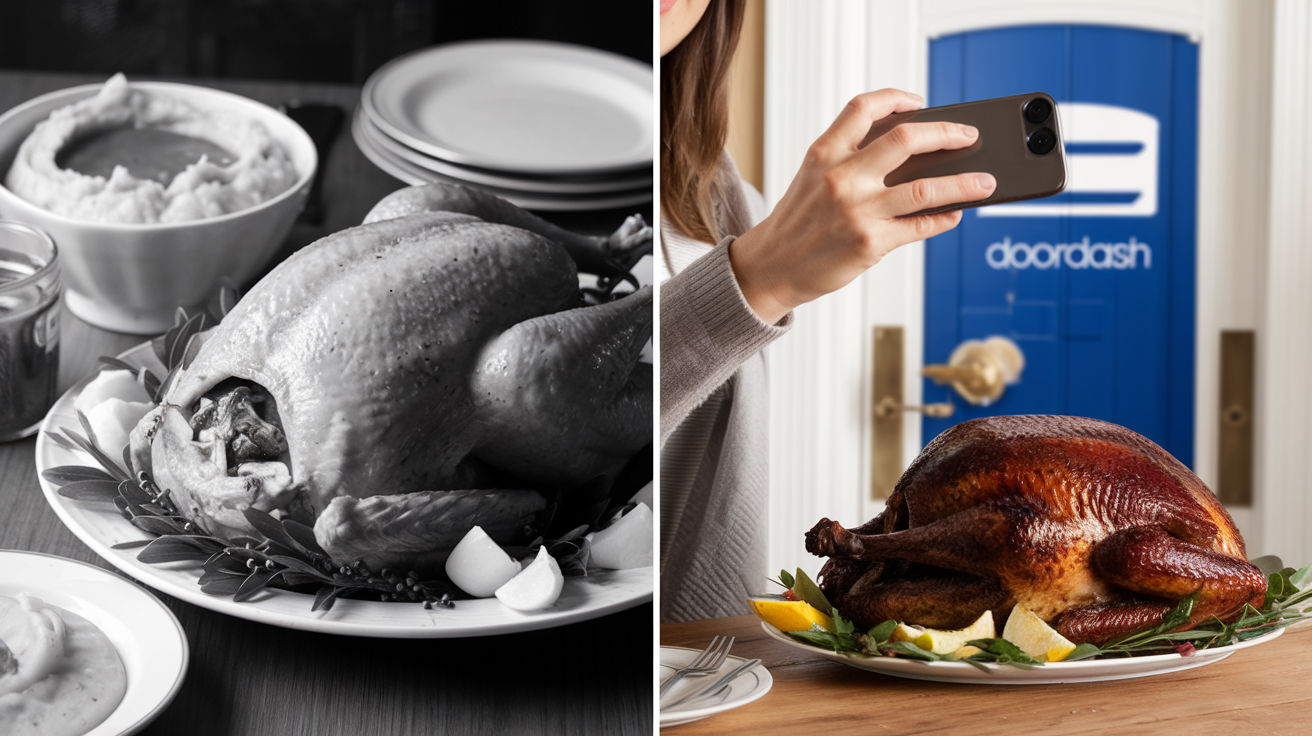I’ll never forget the moment it hit me.
There I was, standing in my kitchen at 6 AM on Thanksgiving morning, staring at a still-frozen turkey like it was a physics equation.
My great-grandmother’s handwritten cookbook lay open on the counter, its pages yellow with age and spotted with the evidence of feasts long past.
And that’s when the existential crisis kicked in.
While desperately googling “how to defrost turkey fast not die food poisoning,” I started thinking about my ancestors.
You know, the ones who actually had to catch their dinner instead of just forgetting to take it out of the freezer at a reasonable hour.
Let me paint you a picture of how different (yet surprisingly similar) our celebrations really are.
And why, despite all our modern conveniences, some things about this holiday never change – no matter how many centuries pass.
They Prepped for Months. I Prep By Watching YouTube Tutorials the Night Before.
My ancestors spent entire seasons preparing for winter feasts. They preserved foods through the scorching summers. Dried herbs in their kitchens until the rafters were full.
Stockpiled supplies like they were preparing for the apocalypse (which, let’s be honest, they kind of were – winter in the old days was no joke).
Me?
I spend 3 hours watching “ULTIMATE THANKSGIVING HACKS” at 11 PM the night before, convinced I’ll somehow absorb cooking skills through osmosis.
I make elaborate Pinterest boards titled “Thanksgiving 2024: This Time It’s Personal” and save recipes I’ll definitely (probably) (maybe) make.
Spoiler alert: It doesn’t work. Neither does panic-buying every herb in the grocery store because you can’t remember which ones actually go in stuffing.
They Hunted Their Own Turkey. I Hunt for Parking at Whole Foods.
My forebears would track wild turkeys through forests, using skills passed down through generations.
They’d wake before dawn, follow tracks through frost-covered ground, and return triumphant with dinner slung over their shoulders.
Meanwhile, I’m fighting Karen in aisle 7 for the last pre-brined Butterball.
Sorry, ancestors. But hey – at least my “hunting” skills include mastering the art of the shopping cart quick-draw and the ability to spot a good deal from 50 paces.
Different skills for different times.
You think tracking a wild turkey through dense forest is hard? Try navigating the Whole Foods parking lot the day before Thanksgiving.
That’s a survival skill my ancestors never had to master.
They Gathered Around Open Hearths. I Gather Around Open Apps.
Picture this: My ancestors, huddled around a crackling fire, sharing stories of harvests and hardships. The flames casting dancing shadows on weather-worn faces as they passed down tales of their own ancestors, keeping their history alive through oral tradition.
Now picture me, huddled around my iPhone, sharing Instagram stories of my slightly burnt stuffing with the caption “nailed it 😅.”
Different medium, same desire to share and connect. Right?
But you know what? Those stories they told around the fire? They were probably complaining about their in-laws too.
Some traditions truly are timeless.
They Celebrated Community. We Still Do (Just With More WiFi).
Despite all the differences, some things haven’t changed.
Like how Aunt Margaret won’t stop asking about your love life – whether it’s 1824 or 2024. Or how there’s always that one relative who insists on bringing up politics during dinner.
My ancestors gathered their entire community for these feasts. Today, we do the same. Sure, some of our guests might be joining via FaceTime, and we’re coordinating arrival times through a group chat named “Thanksgiving 2024 🦃 (Don’t Tell Mom About The Backup Pizza Plan),” but the sentiment remains.
They came together because they needed each other to survive. We come together because, despite all our modern independence, we still need each other to truly live.
They Passed Down Recipes. We Pass Down Screenshots.
Their recipe books were handwritten treasures, passed through generations with notes in the margins.
Stained with gravy and love, these cookbooks told stories of family history through food. Each splash of vanilla extract or thumbprint in the corner had a story behind it.
Mine?
Screenshots of Food Network recipes with comments like “DO NOT TRUST THE COOKING TIME” and “needs more butter (obviously).”
My digital recipe collection might not have the same romantic appeal, but it’s filled with just as much trial and error, just as many memories.
The medium has changed, but the message hasn’t: good food is worth sharing, and family recipes – whether digital or handwritten – are precious heirlooms.
They Gave Thanks for the Harvest. We Give Thanks for Delivery Services.
My ancestors thanked the heavens for bountiful crops and successful hunts. Their gratitude was deeply tied to survival, to the miracle of having enough to eat when times were lean.
I thank the heavens for DoorDash’s “Rescue My Thanksgiving” promotion when things go seriously wrong.
(Yes, this happened. No, we don’t talk about the Great Turkey Fire of 2022. But yes, Chinese food is a perfectly acceptable Thanksgiving dinner when the situation calls for it.)
They Cooked by Intuition. We Cook by Internet.
Their cooking was guided by experience, by touch and smell and the wisdom passed down through generations. They knew the bread was ready by the sound it made when tapped, knew the stew needed more salt without tasting it.
We Google “how to tell if turkey is done” seventeen times and still end up cutting into it to make sure.
We text our moms asking “what does ‘fold in gently’ actually mean?” and watch YouTube videos on how to crimp pie crust.
But here’s what’s beautiful: we’re all just trying our best to feed the people we love.
The Truth About Then and Now
Strip away the technology, the convenience, and the fact that I can order emergency dinner rolls from my phone, and you’ll find something fascinating:
We’re not that different.
My ancestors gathered for the same reasons we do today.
To connect. To share. To remember what matters.
They didn’t have Instagram-worthy table settings or Pinterest-perfect pies. But they had what we’re all really looking for: family, community, and a moment to pause and be grateful.
Sure, the logistics have changed. We’re more likely to stress about WiFi passwords than firewood supplies.
Our feast preparations involve more Amazon Prime than root cellars. And yes, sometimes our backup plan involves pizza delivery instead of hunting wild game.
But at its heart, Thanksgiving remains what it’s always been: a time to gather, to share, to remember that we’re part of something bigger than ourselves.
Whether you’re recreating your great-grandmother’s secret stuffing recipe or frantically Googling “how to save lumpy gravy” on your phone under the table, you’re participating in a tradition that transcends time.
Like my ancestors, I’m creating memories. Building bonds. Sharing stories. My stories might get shared on social media instead of around a fire, but they’re no less real, no less valuable.
And maybe, generations from now, my descendants will look back at our Thanksgivings and laugh at our primitive cooking methods and our quaint social media habits.
But I hope they’ll also see what I see when I look back at my ancestors’ celebrations: the timeless truth that good food, loving family (even the crazy ones), and grateful hearts never go out of style.
Even if your grateful heart is also secretly grateful for backup pizza delivery options.
Because at the end of the day, whether you’re a master hunter-gatherer from centuries past or a modern-day microwave warrior, Thanksgiving has always been about one thing:
Coming together and giving thanks.
(And leftovers. Definitely leftovers.)


